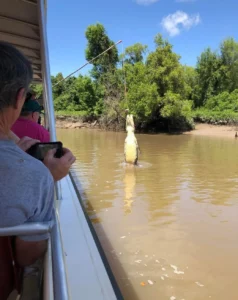
Embark on an unforgettable journey through the heart of Australia’s natural and cultural heritage with this comprehensive travel guide to Kakadu National Park. Spanning across an area of over 19,800 square kilometers, Kakadu is a mosaic of biodiversity, ancient indigenous art, and breathtaking landscapes. From the wetlands teeming with wildlife to the remarkable rock formations, a trip to Kakadu is an experience like no other. Whether you’re interested in a 4-day Kakadu tour or a self-guided adventure, this guide provides you with all the essential information to make your trip a success.
Planning Your Trip to Kakadu National Park

Before you set out to explore the vast terrains of Kakadu National Park, there are some logistics to consider. As the park’s conditions vary greatly between seasons, timing your visit is crucial. Not only will this determine the kind of wildlife you might see but also which activities will be available to you. Entry permits are a necessity as they help maintain the park and you’ll find various accommodation options to suit your preference and budget.
Best Time to Visit:
- Dry Season (May to October): Wildlife viewing is at its prime, water levels are lower, and most of the park’s sites are accessible.
- Wet Season (November to April): A period when the park transforms into a lush, green landscape, with waterfalls in full flow and fewer tourists.
Must-See Attractions in Kakadu National Park
Kakadu National Park is filled with must-see attractions that promise to enrich your travel experience. Discover some of historical significance and witness landscapes that tell the story of the land’s ancient past. These attractions will take your breath away with their natural beauty and give you a deeper understanding of the park’s unique ecosystem and ancient indigenous culture.
Exploring the Rich Indigenous Culture
Kakadu is a living cultural landscape, and the indigenous people have called this place home for tens of thousands of years. The park contains one of the highest concentrated areas of rock art in the world, some of which dates back more than 20,000 years. Here’s where you can immerse yourself in this timeless heritage:
- Ubirr: Renowned for its well-preserved rock paintings and panoramic views of the floodplains.
- Nourlangie: Another rock art site that also serves as a shelter during the wet seasons for thousands of years.
Kakadu also offers cultural tours to learn about the stories and traditions of the indigenous custodians.
Diverse Wildlife and Unique Ecosystems
The park’s floodplains, billabongs, savannas, and monsoon forests host an astonishing array of wildlife. Yellow Water Billabong is one of the best places in Australia to spot saltwater crocodiles in their natural habitat. Kakadu is also a bird watcher’s paradise, with hundreds of species taking refuge in this protected area. Notable wildlife includes:
| Animal | Best Viewing Locations |
|---|---|
| Saltwater Crocodiles | Yellow Water Billabong, East Alligator River |
| Wallabies | Rocky escarpments, open woodland areas |
| Dingoes | Namarrgon Djarr Djarr walk, around the campgrounds |
Adventure and Activities in Kakadu
For those looking to engage with Kakadu actively, the park offers a plethora of adventures. Widely varied, activities range from serene walks to heart-pumping excursions. This section will help you find the ideal way to explore the park’s diverse environments, whether on land or water.
Hiking Trails and Scenic Walks
Kakadu’s landscapes provide a stunning backdrop for hiking enthusiasts. Here you can trek through various types of terrains, from rocky outcrops to lush forest trails. Hikers should always be prepared for the park’s rugged nature and occasionally extreme weather conditions. Here are a few trails to consider:
- Bardedjilidji Walk: A 2.5 km walk that leads you through sandstone country and monsoon forest.
- Yurmikmik Walks: Catering for different fitness levels, these tracks offer views of waterfalls and diverse habitats.
Water-Based Activities
The waterways of Kakadu are just as enticing as its land. Fishing enthusiasts will find a rich environment populated with barramundi and other species. Boating and kayaking through the park’s rivers allow for an intimate experience with Kakadu’s aquatic environments. Be sure to adhere to safety guidelines and respect the local wildlife.
Practical Tips for Visiting Kakadu National Park
Visiting Kakadu National Park requires some preparation to ensure a safe and enjoyable trip. Beyond packing the essentials, visitors should consider the park’s climatic conditions, which can change rapidly. Kangaroo-safe sunscreen, lots of water, comfortable hiking boots, and a comprehensive first aid kit are among the crucial items.
Here are other practical tips to keep in mind:
- Stay informed about the weather and potential road closures, especially during the wet season.
- Be aware of your surroundings; although beautiful, Kakadu is also a wilderness with potential hazards.
- Plan your itinerary carefully to ensure that you get to experience the full richness of the park.
Capturing Memories: Photography Tips
Capturing the essence of Kakadu through the lens is a rewarding pursuit. Early morning or late afternoon light offers the soft glow that photographers covet. Consider these tips when trying to capture the park’s stunning vistas and native wildlife.
The sprawling landscapes of Kakadu give rise to extraordinary photo opportunities. Key locations like Ubirr and Nourlangie provide sweeping views over the floodplains and escarpments – perfect for those stunning panoramic shots.
For those with an eye for fauna, patience and quietness are essential. A good telephoto lens can help maintain a safe distance while still capturing the intimate details of Kakadu’s wildlife.
Kakadu National Park is a shining example of ecotourism done right. Your visit not only contributes to the conservation efforts but also supports the indigenous communities that have preserved this land for millennia. By participating in 4-day Kakadu tours or engaging in community-run activities, you can help ensure that the park remains a vibrant, living cultural landscape.
Conclusion
Kakadu National Park offers an abundance of natural beauty and cultural richness that will leave a lasting impact on all who visit. With the right preparation and respect for the environment, your journey through Kakadu will be one of adventure, learning, and unforgettable memories. Step into this ancient land and discover the wonders that have preserved for tens of thousands of years.
FAQs about Traveling to Kakadu National Park
Q1: Do I need a permit to visit Kakadu National Park?
A1: Yes, visitors are required to purchase a park pass, which contributes to the conservation efforts and management of the park.
Q2: What is the best time of year to visit the park?
A2: The best time to visit Kakadu is during the dry season from May to October when the weather is cooler and more attractions are accessible.
Q3: Are there guided tours available within Kakadu National Park?
A3: Yes, there are various guided tours available that cater to different interests, including cultural tours, wildlife tours, and adventure activities.
Q4: What wildlife might I see in Kakadu National Park?
A4: Kakadu is home to a variety of wildlife, including saltwater crocodiles, wallabies, dingoes, and over 280 bird species.
Q5: Can I swim in the waters of Kakadu National Park?
A5: While there are some designated swimming areas, many of the park’s waterways are home to saltwater crocodiles, and swimming is not recommended unless in a clearly marked safe area.

